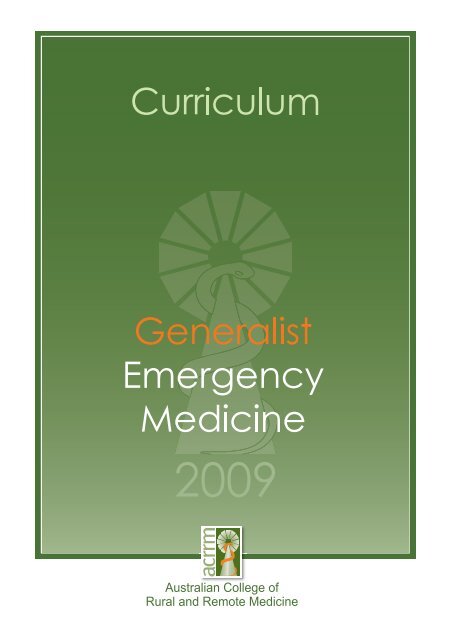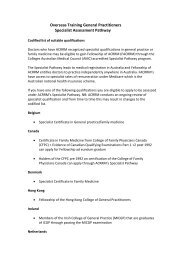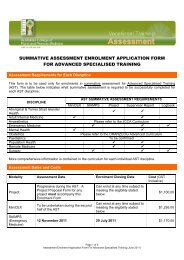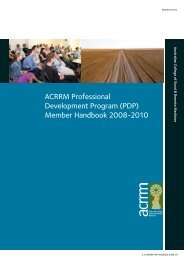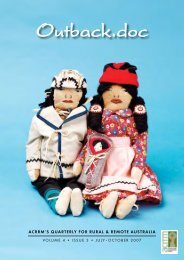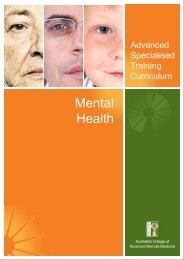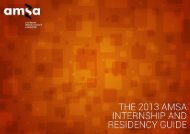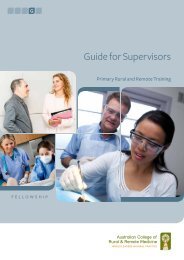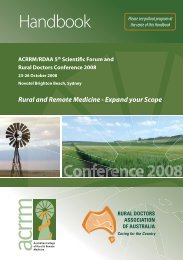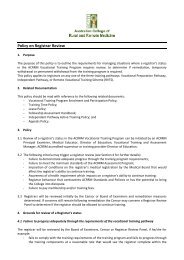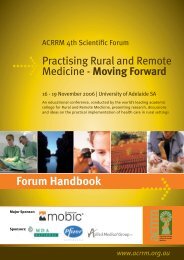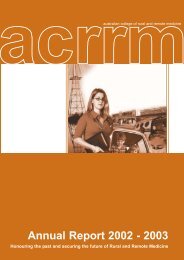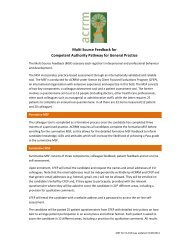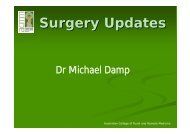ACRRM GEM Curriculum - Final July09 - Australian College of Rural ...
ACRRM GEM Curriculum - Final July09 - Australian College of Rural ...
ACRRM GEM Curriculum - Final July09 - Australian College of Rural ...
Create successful ePaper yourself
Turn your PDF publications into a flip-book with our unique Google optimized e-Paper software.
ACKNOWLEDGMENTS<br />
<strong>ACRRM</strong> wishes to thank the following people for their time and expertise in the development <strong>of</strong><br />
this curriculum statement:<br />
Dr Peter Arvier BSc MBBS MMedSc F<strong>ACRRM</strong> – Associate Head, <strong>Rural</strong> Clinical School,<br />
University <strong>of</strong> Tasmania – Principle Writer<br />
Dr Victoria Brazil MBBS FACEM – Staff Specialist, Emergency Medicine, Royal Brisbane<br />
and Women’s Hospital<br />
Dr Greg Treston BMedSc MBBS DTMH DIMCRCS F<strong>ACRRM</strong> FACEM – Director <strong>of</strong><br />
Emergency Medicine, Bundaberg Base Hospital, QLD<br />
Dr Stephen Brierley MBBS MHA MSpMed DA FRACGP FRACMA FACEM– Director <strong>of</strong><br />
Emergency, Ipswich Hospital, QLD<br />
Dr Paul de Jong MBChB MFamMed F<strong>ACRRM</strong> FRACGP DRANZCOG – District Director<br />
Emergency Medicine, Fraser Coast Health, QLD<br />
Dr Chris May MBBS FRACGP FACEM – Director, Emergency Department, Redlands<br />
Hospital, QLD<br />
Dr Peter Thompson BSc(Hons) MBBS FRCS FCEM FACEM – Director, Emergency<br />
Department, Rockhampton Base Hospital, QLD<br />
Dr Katie Mills MBBS FACEM – Staff Specialist, Toowoomba Hospital, QLD<br />
Dr Colin Myers MBChB DipO&G FRNZCGP FACEM – Director <strong>of</strong> Emergency Medicine, The<br />
Prince Charles Hospital, Brisbane, QLD<br />
Dr Eric Van Puymbroeck MBChB MPhil FACEM – Emergency Physician, Noosa Hospital,<br />
QLD<br />
Dr Peter Pereira MBBS FACEM – Director, Emergency Medicine, Cairns Base Hospital,<br />
QLD, and Associate Pr<strong>of</strong>essor, James Cook University, and<br />
Dr Kees Nydam MBBS FACEM FAChAM MRACMA GradDipMedEd – Clinical Director<br />
Alcohol Tobacco and Other Drugs Service (ATODS) Wide Bay QLD, Director Clinical<br />
Training Bundaberg Hospital QLD, and Clinical Director University <strong>of</strong> Queensland School<br />
<strong>of</strong> Medicine, <strong>Rural</strong> Clinical Division, Bundaberg Campus.<br />
We would also like to thank A/Pr<strong>of</strong> Janie Dade Smith, Director, RhED Consulting Pty Ltd for her<br />
advice and assistance during the curriculum development process.<br />
1
TABLE OF CONTENTS<br />
PAGE<br />
ACKNOWLED<strong>GEM</strong>ENTS 1<br />
1 BACKGROUND 3<br />
2 PURPOSE AND REQUIREMENTS 4<br />
2.1 Purpose 4<br />
2.2 Target group 4<br />
2.3 Duration 4<br />
2.4 Potential posts 4<br />
2.5 Prerequisites 5<br />
3 RATIONALE 6<br />
4 LEARNING OUTCOMES 7<br />
4.1 Core clinical knowledge and skills 9<br />
4.2 Extended clinical practice 10<br />
4.3 Emergency care 13<br />
4.4 Population health 20<br />
4.5 Aboriginal and Torres Strait Islander health 21<br />
4.6 Pr<strong>of</strong>essional, legal and ethical practice 22<br />
4.7 <strong>Rural</strong> and remote context 23<br />
5 TEACHING AND LEARNING APPROACHES 25<br />
6 SUPERVISION AND SUPPORT 25<br />
7 ASSESSMENT 26<br />
8 ESSENTIAL RESOURCES 27<br />
9 EVALUATION 27<br />
2
1. BACKGROUND<br />
This Generalist Emergency Medicine <strong>Curriculum</strong> builds on the Advanced Specialised Training<br />
<strong>Curriculum</strong> in Emergency Medicine and on the emergency medicine component <strong>of</strong> the <strong>ACRRM</strong><br />
Primary <strong>Curriculum</strong>.<br />
This curriculum recognizes that the scope and depth <strong>of</strong> knowledge and skills required by a<br />
Generalist Emergency Medicine doctor will vary depending on the location <strong>of</strong> practice. Numerous<br />
factors may impact clinical experience and requirements including the urgency <strong>of</strong> the clinical<br />
situations encountered the frequency <strong>of</strong> encounters and the availability <strong>of</strong> on-site support<br />
services. However, this curriculum seeks to define the generic minimum standards required for<br />
Generalist Emergency Medicine practice across the range <strong>of</strong> potential contexts.<br />
By its nature, the practice <strong>of</strong> emergency medicine also has considerable overlap with a number <strong>of</strong><br />
other specialist disciplines, particularly anaesthetics, surgery, orthopaedics, internal medicine,<br />
and paediatrics. Acute aspects <strong>of</strong> most disciplines have relevance to the practice <strong>of</strong> emergency<br />
medicine.<br />
3
2. PURPOSE AND REQUIREMENTS<br />
2.1 Purpose<br />
The aim <strong>of</strong> this curriculum is define the competencies required for independent Generalist<br />
Emergency Medicine practice in settings outside major metropolitan hospitals where there is not<br />
immediate on-site support from specialist practitioners.<br />
2.2 Target group<br />
This curriculum targets Fellows <strong>of</strong> <strong>ACRRM</strong> with an Advanced Skills Training year in Emergency<br />
Medicine (or equivalent qualifications and experience) who are undertaking Generalist Emergency<br />
Medicine training. It would be <strong>of</strong> most relevance to doctors wishing to pursue a career in<br />
emergency medicine at a senior level outside major metropolitan hospitals.<br />
2.3 Duration<br />
The minimum period <strong>of</strong> time required for Generalist Emergency Medicine training is 18 months<br />
full time or equivalent part time. It is recommended that this period should consist <strong>of</strong>:<br />
12 months emergency medicine<br />
3 months anaesthesia (or suitable structured learning program in emergency airway<br />
management and emergency ventilation with certified competence), and<br />
3 months critical care (ICU/CCU).<br />
The training program will take into account other pr<strong>of</strong>essional, personal and family needs and will<br />
<strong>of</strong>fer the flexibility for individuals to undertake part time training. It will also allow flexibility for<br />
participants to undertake their Generalist Emergency Medicine training in two or more blocks,<br />
and will not disadvantage trainees who choose this option. As far as possible, time in anaesthesia<br />
and critical care should be undertaken as single continuous blocks.<br />
2.4 Potential posts<br />
Generalist Emergency Medicine training must be undertaken in institutions accredited by <strong>ACRRM</strong>.<br />
Such institutions must have the caseload and teaching capacity to provide training in a sufficient<br />
range <strong>of</strong> emergency conditions to meet the requirements <strong>of</strong> this curriculum.<br />
The majority <strong>of</strong> training must be completed in a hospital with the following features:<br />
a 24 hour medically staffed emergency department<br />
a Director <strong>of</strong> Emergency Medicine with appropriate postgraduate qualifications<br />
4
specialist inpatient services covering the core disciplines <strong>of</strong> General Surgery,<br />
Orthopaedics, Internal Medicine, Paediatrics and Psychiatry<br />
access for trainees to support and supervision by experienced clinicians at all times, and<br />
the commitment and ability to provide the required level <strong>of</strong> teaching and experience.<br />
Trainees should spend significant time in an emergency department, anaesthesia department,<br />
intensive care department, and coronary care unit. It would be highly desirable that trainees also<br />
undertake a brief attachment in a smaller rural or remote hospital emergency department for an<br />
understanding <strong>of</strong> the particular challenges <strong>of</strong> delivering emergency care in those settings.<br />
Periods <strong>of</strong> attachments to larger institutions or specialist hospitals may be highly desirable for<br />
areas such as critical care, women’s health and children’s health. This may be especially<br />
important for trainees at smaller institutions with lower acuity case mix.<br />
2.5 Prerequisites<br />
Prior to undertaking <strong>GEM</strong> training, the trainee must have:<br />
completed F<strong>ACRRM</strong> training (or equivalent)<br />
completed an Advanced Specialised Training year in Emergency Medicine, and<br />
satisfactorily completed the Early Management <strong>of</strong> Severe Trauma (EMST), Emergency<br />
Life Support (ELS) and Advanced Paediatric Life Support (APLS) courses (or equivalent)<br />
This Generalist Emergency Medicine <strong>Curriculum</strong> assumes as pre-requisite knowledge and skills all<br />
the competencies set out in the Advanced Specialised Training <strong>Curriculum</strong> in Emergency<br />
Medicine. In particular, the following competencies have been assumed:<br />
high-level competence in Advanced Life Support<br />
high-level competence in primary and secondary survey<br />
recognition <strong>of</strong> the compromised/at risk airway<br />
competent basic airway manoeuvres<br />
competent in basic intubation<br />
basic ventilation techniques – EAR, bag/mask ventilation<br />
principles <strong>of</strong> oxygenation and ventilation<br />
perform and interpret Adult and Paediatric Glasgow Coma Scales, and<br />
competent common emergency procedures, as outlined in the <strong>ACRRM</strong> Primary<br />
<strong>Curriculum</strong> and Advanced Specialised Training <strong>Curriculum</strong> in Emergency Medicine.<br />
5
3. RATIONALE<br />
There are a number <strong>of</strong> important differences between emergency medicine practice in rural and<br />
regional locations and that in major metropolitan settings. Even when considering larger regional<br />
hospitals, key differences such as limited physical resources, fewer specialist staff, and long lead<br />
times for retrieval to more specialized centres differentiate these from their major metropolitan<br />
counterparts. Such differences mean that generalist emergency medicine doctors are required to<br />
practice a broader range <strong>of</strong> skills with a greater degree <strong>of</strong> autonomy than many <strong>of</strong> their<br />
colleagues in metropolitan teaching hospitals.<br />
The scope <strong>of</strong> practice required by the generalist emergency medicine doctor will vary depending<br />
on the location <strong>of</strong> practice. This curriculum seeks to outline the generic requirements that define<br />
safe and competent generalist emergency medicine practice across the range <strong>of</strong> Generalist<br />
Emergency Medicine contexts.<br />
It is noted that many patients who present to emergency departments do not have life<br />
threatening emergency conditions. However, their management in the emergency department<br />
may be appropriate under various circumstances. Such situations are not included in this<br />
curriculum and fall under primary training covered in the Primary <strong>Curriculum</strong>.<br />
The focus <strong>of</strong> this curriculum is on building the clinical skills required for Generalist Emergency<br />
Medicine practice. However, the leadership and management aspects <strong>of</strong> Generalist Emergency<br />
Medicine practice are also taken into consideration and highlighted.<br />
6
4. LEARNING OUTCOMES<br />
The Domains <strong>of</strong> rural and remote general practice, as defined by <strong>ACRRM</strong>, provide a framework<br />
for organising the learning outcomes for this curriculum. The domains are:<br />
1. Core clinical knowledge and skills<br />
2. Extended clinical practice<br />
3. Emergency care<br />
4. Population health<br />
5. Aboriginal and Torres Strait Islander health<br />
6. Pr<strong>of</strong>essional, legal and ethical practice, and<br />
7. <strong>Rural</strong> and remote context.<br />
These domains are integrated with the Fields <strong>of</strong> competency essential to the rural or regional<br />
generalist emergency medicine doctor:<br />
Initial management<br />
Definitive emergency care<br />
Common emergency procedures<br />
Ongoing management<br />
Recognition and management <strong>of</strong> unusual but serious conditions<br />
Transfer and transportation<br />
Utilisation <strong>of</strong> available resources<br />
Communication, and<br />
Leadership and teamwork.<br />
The competency framework in Table 1 outlines the practice requirements for the Generalist<br />
Emergency Medicine doctor. It defines the level <strong>of</strong> autonomy required in the management <strong>of</strong><br />
various types <strong>of</strong> clinical emergencies and non-clinical responsibilities – from completely<br />
autonomous management (A) to management with distant guidance (D), or with on-site<br />
support (O). It also defines the integration between the Domains <strong>of</strong> rural and remote general<br />
practice and the Fields <strong>of</strong> competency.<br />
7
Table 1: COMPETENCY FRAMEWORK<br />
Key: A = manage autonomously, D = manage with distant guidance, O = manage with on-site<br />
support, n/a = not applicable<br />
FIELDS OF COMPETENCY<br />
Initial management<br />
Time-critical & definitive<br />
emergency care<br />
Common emergency<br />
procedures<br />
Ongoing management<br />
Uncommon but serious<br />
conditions<br />
Transfer /<br />
transportation<br />
Utilisation <strong>of</strong> available<br />
resources<br />
Communication<br />
Leadership and<br />
teamwork<br />
Integrated domains 3,7 3,7 3 1,4 2 3 6<br />
CLINICAL CONTENT AREAS<br />
Airway emergencies A A A D D D A A A<br />
Respiratory emergencies A A A D D D A A A<br />
Anaesthesia and analgesia A D A O O D A A D<br />
Circulatory emergencies A A A D O D A A A<br />
Other causes <strong>of</strong> shock A D A D D D A A A<br />
Neurological emergencies A A A D D D A A A<br />
Psychiatric emergencies A D A O D D D A A<br />
Musculo-skeletal emergencies A D A D D A A A A<br />
S<strong>of</strong>t tissue emergencies and burns A A A D D A A A A<br />
ENT, Dental and maxill<strong>of</strong>acial emergencies A A A D D D A A A<br />
Abdominal and genito-urinary emergencies A D A D D A A A A<br />
Ophthalmological emergencies A D A D O D A A A<br />
Metabolic and endocrine emergencies A A A D D D A A A<br />
Dermatological emergencies A A A D D A A A n/a<br />
Toxicology and toxinology A D A D D A A A A<br />
Environmental emergencies A A A D D D D A D<br />
Infectious diseases A D A D D D D A D<br />
1,5<br />
,6<br />
Sepsis A A A D O D A A A<br />
Paediatric and neonatal emergencies A D A D O D A A D<br />
Obstetric and gynaecological emergencies D D D O O D D A D<br />
NON-CLINICAL CONTENT AREAS<br />
Forensic medicine and legal issues A D A D D D A A D<br />
Retrieval and special transport A D A D D n/a A A A<br />
Imaging and laboratory investigations A A A D D n/a A A n/a<br />
General topics A D A D D D D A D<br />
Emergency department management A n/a A O D D A A A<br />
2,6<br />
8
4.1 Domain 1. Core clinical knowledge and skills<br />
The trainee will:<br />
Diagnostic investigations – Demonstrate high-level understanding <strong>of</strong> the selection criteria,<br />
protocols, principles and limitations <strong>of</strong> the following tests, and demonstrate the ability to<br />
competently perform the following tests and interpret their results:<br />
point <strong>of</strong> care pathology including venom detection kit (VDK)<br />
arterial blood gas<br />
lumbar puncture and CSF manometry<br />
plain x-rays – high-level competence in emergency interpretation pending definitive<br />
reporting, including adult and paediatric chest, spine, abdomen and extremities<br />
CT scans – competent emergency interpretation, pending definitive reporting<br />
emergency use <strong>of</strong> intravenous contrast<br />
electrocardiography (ECG)<br />
Focused Assessment with Sonography for Trauma (FAST) ultrasound<br />
Abdominal Aortic Aneurysm (AAA) ultrasound<br />
ultrasound for vascular access<br />
ultrasound in early pregnancy<br />
swallowing assessment<br />
oximetry<br />
capnography, and<br />
cardiotocography (CTG).<br />
Telemedicine – Demonstrate high-level skills in use <strong>of</strong> tele-medicine technology, including:<br />
uploading x-rays, clinical images and other data to consult with distant specialists,<br />
and<br />
clinical photography skills.<br />
Ongoing management – Demonstrate the ability to provide appropriate post-stabilisation<br />
care to emergency patients, including:<br />
management to maintain the patient in a stable condition prior to admission to an<br />
inpatient unit or transfer to another facility, and<br />
preparation for transfer.<br />
Complicating anatomical conditions – Discuss the features <strong>of</strong> congenital and acquired<br />
conditions that may predispose patients to emergency presentations and/or complicate<br />
emergency management:<br />
congenital heart disease<br />
congenital maxill<strong>of</strong>acial and other anatomical abnormalities, and<br />
acquired anatomical abnormalities.<br />
9
Rational and safe prescribing – Demonstrate the ability to consistently make rational and<br />
safe prescribing decisions in the emergency department.<br />
Doctor-patient communication – Demonstrate the ability to utilise effective and<br />
appropriate communication skills and strategies with emergency patients and/or their family<br />
members and friends across the spectrum <strong>of</strong> ages, disability levels, and culturally and<br />
linguistically diverse backgrounds:<br />
pr<strong>of</strong>iciency in spoken and written English<br />
taking sensitive, difficult and/or complex case histories – e.g. psychiatric patients,<br />
sexual assault and domestic violence victims, adolescent patients, patients with<br />
speech impairment from strokes<br />
showing understanding, sensitivity and respect for the communication styles and<br />
social dynamics <strong>of</strong> different cultural groups in highly stressful situations<br />
use <strong>of</strong> interpreter services<br />
dealing with distressed relatives<br />
effective communication with aggressive and other ‘difficult’ patients<br />
assisting junior staff members in difficult situations, and<br />
recognising unsuccessful communication and attempting different strategies.<br />
Refugee and migrant health – Knowledge <strong>of</strong> particular medical conditions and needs <strong>of</strong><br />
refugees and migrants arriving in Australia.<br />
4.2 Domain 2. Extended clinical practice<br />
The trainee will:<br />
Differential diagnosis – Demonstrate the ability to make accurate and timely differential<br />
diagnoses in emergency situations.<br />
Uncommon but serious conditions – Outline the diagnostic features and initial<br />
management <strong>of</strong> rarely encountered and diagnostically difficult conditions which have<br />
potentially serious consequences if misdiagnosed. The following list illustrates some examples<br />
<strong>of</strong> such uncommon but serious conditions:<br />
acute epiglottitis<br />
traumatic rupture <strong>of</strong> the diaphragm<br />
dissecting thoracic aortic aneurysm<br />
spinal cord injury without radiological abnormality<br />
non-accidental injury<br />
concealed pregnancy<br />
abdominal sepsis in the elderly, and<br />
exotic infections.<br />
10
Secondary injuries – Outline the risk factors for secondary injuries in emergency patients,<br />
discuss strategies for reducing these risks, and outline appropriate management <strong>of</strong> secondary<br />
injuries if/when they occur:<br />
renal failure<br />
cardiac failure<br />
adult respiratory distress syndrome (ARDS)<br />
disorders <strong>of</strong> coagulation<br />
cerebral hypoxia<br />
multi-system failure<br />
sepsis, and<br />
neurovascular compromise.<br />
Anaesthesia and analgesia – Demonstrate high-level competence in anaesthetic and<br />
analgesic decision-making and delivery:<br />
discuss the factors involved in making difficult anaesthetic decisions – neonates,<br />
young children, elderly, shock, co-morbidities, burns, facial and neck trauma,<br />
congenital abnormalities, obesity<br />
demonstrate the ability to apply these decision making skills appropriately in real-life<br />
or simulated emergency situations<br />
demonstrate high-level ability in the following basic anaesthetic techniques:<br />
drug dosage and calculations<br />
regional nerve blocks<br />
rapid sequence induction<br />
neuroleptanaesthesia<br />
pain monitoring during anaesthesia, and<br />
procedural sedation and monitoring, including combination and dissociative<br />
agents<br />
demonstrate competent independent ability in the following post-basic anaesthetic<br />
techniques:<br />
pre-intubation airway assessment<br />
inhaled anaesthesia<br />
anaesthetic induction and maintenance<br />
rapid sequence induction<br />
regional anaesthetic techniques<br />
management <strong>of</strong> malignant hyperpyrexia and suxamethonium apnoea, and<br />
anaesthetic techniques for dental emergencies<br />
demonstrate competence in the following advanced anaesthetic techniques:<br />
11
identification <strong>of</strong> failed intubation<br />
failed intubation drill and equipment failure drill<br />
use <strong>of</strong> LMA, ILMA and other alternative airways<br />
jet insufflation and surgical airway techniques<br />
set-up and use <strong>of</strong> non-invasive ventilation and portable ventilation<br />
anaesthesia monitoring<br />
Demonstrate competent, safe, effective independent administration <strong>of</strong> emergency,<br />
post-operative and labour analgesia – including intravenous, but excluding epidural.<br />
Referral and transfer – Demonstrate the ability to identify those patients requiring referral<br />
and transfer to a higher level <strong>of</strong> care, and to safely manage the referral and transfer process;<br />
this includes:<br />
knowing own limitations<br />
knowing when, how and where to refer appropriately<br />
maintaining patient in a stable condition until handover to appropriate transportation<br />
completing required legal documentation for involuntary transportation <strong>of</strong> patients<br />
with acute psychosis.<br />
Handover – Demonstrate the ability to undertake safe and effective handover <strong>of</strong> patients<br />
within the emergency department and during intra-hospital and inter-hospital transfers.<br />
Patient discharge – Demonstrate the ability to identify which patients may be safely<br />
discharged from the emergency department for ongoing care in the community, and to safely<br />
manage the discharge process:<br />
discharge assessment<br />
arranging discharge medication<br />
communicating with general practitioner and community services, and<br />
discharge report/paperwork.<br />
Palliative care – Demonstrate the ability to provide appropriate palliative care in the<br />
emergency department for patients awaiting admission or transfer to an appropriate facility.<br />
Forensic medicine – Demonstrate high-level understanding <strong>of</strong> the clinical and medico-legal<br />
requirements for management <strong>of</strong> physical and/or sexual assault cases, including:<br />
sexual assault examination and specimen collection<br />
recognition <strong>of</strong> non-accidental injury patterns in children and domestic partners<br />
understanding <strong>of</strong> the Coronial investigation process<br />
writing medico-legal reports<br />
giving evidence in court, and<br />
treatment <strong>of</strong> minors and persons in custody.<br />
12
Use <strong>of</strong> blood and blood products – Demonstrate the ability to consistently make rational<br />
and safe decisions regarding the use <strong>of</strong> blood and blood products in the emergency<br />
department.<br />
Leadership and teamwork – Demonstrate the ability to take a clinical and operational<br />
leadership role in the emergency department and to work as an effective team member or<br />
<strong>of</strong>fer leadership to inter-pr<strong>of</strong>essional teams where appropriate, including:<br />
co-ordinating and managing a team,<br />
working appropriately and effectively with emergency services (police, fire brigade,<br />
ambulance), and retrieval services<br />
working as an effective team member in a non-leadership role where appropriate,<br />
and<br />
providing leadership to emergency department staff members, inpatient services,<br />
and non-medically trained individuals.<br />
4.3 Domain 3. Emergency care<br />
The trainee will:<br />
Triage – Outline the principles <strong>of</strong> triage and discuss their application to emergency<br />
situations.<br />
Initial assessment and stabilisation – Demonstrate (in either real or simulated contexts),<br />
high-level competence in initial assessment and stabilisation <strong>of</strong> the entire range <strong>of</strong> acute<br />
illness and injury, including:<br />
competent advanced life support<br />
complex resuscitation<br />
recognition <strong>of</strong> the seriously unwell conscious patient, including ability to identify<br />
relevant “red flags”<br />
appropriate prioritization and sequencing <strong>of</strong> assessments, investigations and<br />
management tasks in emergency cases, including:<br />
seriously unwell conscious patients<br />
patients with undifferentiated severe acute pain<br />
undifferentiated unconscious patients<br />
undifferentiated sick children<br />
major/serious/complicated adult and paediatric trauma – multiple trauma,<br />
head trauma, chest, pelvic, spine, major limb, maxill<strong>of</strong>acial, abdominal (blunt<br />
and penetrating),<br />
acutely psychotic patients, including suicide risk assessment<br />
undifferentiated acute infections, and<br />
13
assessment and management <strong>of</strong> multiple casualty scenarios.<br />
Advanced emergency procedures – Discuss selection principles and competently<br />
demonstrate a comprehensive range <strong>of</strong> advanced emergency procedures, including:<br />
high-level skills in difficult airway maintenance – including C-spine trauma, burns,<br />
maxill<strong>of</strong>acial and laryngeal trauma, laryngeal oedema, swelling, epiglottitis, foreign<br />
body, anatomical abnormalities and variations:<br />
non-standard positioning<br />
non-standard laryngoscopes<br />
bougies and introducers<br />
rapid sequence induction<br />
high-level competence in laryngeal mask airway (LMA)<br />
high-level competence in intubating laryngeal mask airway (ILMA)<br />
competent, independent needle cricothyroidotomy and other percutaneous<br />
cricothyroidotomy techniques, and<br />
high-level competence in surgical cricothyoidotomy under supervision.<br />
advanced ventilation techniques – for situations including acute pulmonary oedema,<br />
severe asthma, acute or severe respiratory infections, blunt or penetrating chest<br />
trauma, near drowning, and pulmonary aspiration:<br />
high-level competence in manual ventilation techniques<br />
mechanical ventilation techniques<br />
high-level competence in non-invasive ventilation, and<br />
use <strong>of</strong> a portable ventilator<br />
insertion <strong>of</strong> chest drains<br />
difficult intra-venous placements:<br />
non-standard sites<br />
intra-osseous insertion, and<br />
venous cutdown<br />
central venous access and central venous pressure (CVP) monitoring<br />
arterial line insertion<br />
use <strong>of</strong> syringe drivers and fluid pumps<br />
rapid infusion techniques, and<br />
monitoring fluid balance.<br />
Time-critical and Definitive emergency management – Demonstrate high-level ability<br />
in providing safe and effective time-critical and definitive emergency management for a<br />
comprehensive range <strong>of</strong> emergency conditions, including:<br />
14
airway and breathing emergencies – difficult foreign bodies, severe asthma,<br />
respiratory distress tension pneumothorax, compromised airways, hypoventilation,<br />
hypoxia, and chest trauma<br />
competent, independent needle thoracocentesis, and<br />
competent, independent intercostal catheter insertion and chest drainage<br />
circulation emergencies – chest pain, acute coronary syndromes, cardiogenic shock,<br />
hypovolaemic shock, hypertensive emergencies, haemostatic emergencies, cardiac<br />
tamponade, acute myocardial infarction, thrombo-embolic emergencies including<br />
pulmonary embolism, gas embolism, and anaphylaxis:<br />
application <strong>of</strong> Advanced Cardiac Life Support (ACLS) algorithms<br />
defibrillation, cardioversion and external cardiac pacing<br />
cardiac monitoring<br />
risk stratification<br />
thrombolytic therapy, including management <strong>of</strong> complications<br />
cCompetent and independent platelet inhibitor and anticoagulant therapy<br />
competent and independent hypotensive therapy<br />
competent periocardiocentesis with on-site or distant guidance<br />
competent and independent haemostatic therapy<br />
anti-arrhythmic therapy, including management <strong>of</strong> complications<br />
competent and independent administration <strong>of</strong> inotropes and other pressor<br />
agents<br />
principles <strong>of</strong> angioplasty and stenting, including management <strong>of</strong><br />
complications<br />
principles <strong>of</strong> occult blood loss in trauma, and<br />
competent and independent blood transfusion and fluid resuscitation<br />
including principles <strong>of</strong> minimum volume fluid resuscitation<br />
neurologic emergencies – neurologic trauma, coma, stroke, cerebral ischaemia,<br />
space occupying lesions, intracranial haemorrhage, subarachnoid haemorrhage,<br />
altered mental status, acute confusional states, delirium, undifferentiated headache,<br />
Guillian-Barre Syndrome, seizures, status epilepticus, meningitis, neurogenic shock<br />
seizure monitoring and control<br />
competent performance <strong>of</strong> burr hole with distant guidance from a<br />
neurosurgeon<br />
competent immediate care <strong>of</strong> patient with a neurological deficit<br />
15
musculoskeletal emergencies – simple and complex fractures and dislocations,<br />
compound wounds, spinal injuries, ischaemic limbs, degloving injury, amputated<br />
digits, acute back pain/sciatica, and injuries with neurovascular compromise<br />
competent and independent splinting, casting and reduction <strong>of</strong> simple<br />
fractures and dislocations<br />
reduction/stabilisation <strong>of</strong> complex fractures/dislocations under guidance,<br />
including minimisation <strong>of</strong> neurovascular compromise<br />
initial management <strong>of</strong> compound wounds<br />
initial management <strong>of</strong> spinal injuries, including awareness <strong>of</strong> patterns <strong>of</strong><br />
spinal injury without radiological abnormality<br />
repair <strong>of</strong> simple tendon injuries<br />
competent and independent joint aspiration, and<br />
compartment syndrome identification, monitoring, and initial management<br />
including escharotomy<br />
dermatological and s<strong>of</strong>t tissue emergencies – foreign bodies, abscesses, thermal,<br />
chemical and electrical burns, inhalational burns, frostbite, necrotising infections, bite<br />
wounds, contaminated wounds, atrophic skin, lip and face wounds, joint wounds,<br />
crush injury, neurovascular injury, degloving injury, acute desquamating conditions:<br />
removal <strong>of</strong> superficial foreign bodies<br />
competent and independent abscess drainage<br />
assessment <strong>of</strong> wounds for closure suitability<br />
management <strong>of</strong> difficult wounds<br />
competent and independent initial management <strong>of</strong> moderate and severe<br />
burns<br />
initial management <strong>of</strong> rhabdomyolysis/acidosis<br />
competent and independent pressure care <strong>of</strong> s<strong>of</strong>t tissues at risk from<br />
ischaemia and infection<br />
competence in common plastic surgical techniques to improve cosmetic<br />
appearance and cover defects, and<br />
regulation <strong>of</strong> body temperature in patients with dermatological emergencies<br />
Obstetric and gynaecologic emergencies – haemorrhage in early pregnancy, trauma<br />
in pregnancy, miscarriage, precipitate delivery, common labour and delivery<br />
complications, hypertensive urgencies, hyperemesis, pre-eclampsia, eclampsia, and<br />
post-partum problems including fluid embolus, uterine rupture, haemorrhage, sepsis,<br />
and retained products <strong>of</strong> conception (POC):<br />
initial management <strong>of</strong> haemorrhage in early pregnancy<br />
16
initial management <strong>of</strong> trauma in pregnancy<br />
management <strong>of</strong> miscarriage<br />
timely recognition and transfer <strong>of</strong> patients requiring surgical intervention<br />
management <strong>of</strong> common labour and delivery complications<br />
seizure control in eclampsia<br />
competent and independent management <strong>of</strong> precipitate delivery, and<br />
competent initial management <strong>of</strong> post-partum complications<br />
abdominal and urologic emergencies – acute renal failure, foreign body ingestion,<br />
abdominal trauma, acute urinary retention, renal or ureteric calculi, oesophageal<br />
varices, paraphimosis, acute ano-rectal conditions:<br />
initial management <strong>of</strong> acute renal failure<br />
removal <strong>of</strong> accessible GI foreign bodies<br />
urethral and suprapubic catheterisation<br />
control <strong>of</strong> oesophageal varices, and<br />
reduction <strong>of</strong> paraphimosis with on-site or distant guidance<br />
metabolic and endocrine emergencies – hypoglycaemia, diabetic ketoacidosis (DKA),<br />
hyperosmolar non-ketotic states, hypokalaemia, hyperkalaemia, hypocalcaemia,<br />
hypercalcaemia, hyponatraemia, and Addisonian crisis:<br />
competent and independent insulin infusion<br />
competent and independent intravenous electrolyte management, and<br />
competent and independent IV fluids for endocrine emergencies<br />
acute infections – Undifferentiated sepsis, septicaemia, urosepsis, neutropenic sepsis,<br />
meningitis, febrile convulsion, septic shock, exotic infectious diseases, nosocomial<br />
infections, needle stick injury and other body fluid exposure, and infections in<br />
immunocompromised patients:<br />
chemotherapeutics for undifferentiated sepsis<br />
management <strong>of</strong> needle stick injury and other body fluid exposure<br />
implementation <strong>of</strong> infection control procedures, isolation techniques, public<br />
health reporting procedures and management <strong>of</strong> contact persons<br />
management <strong>of</strong> acute infections in immunocompromised patients<br />
outline the common sources <strong>of</strong> sepsis<br />
management <strong>of</strong> the processes and systems involved in obtaining<br />
microbiological specimens, and<br />
discuss the role <strong>of</strong> surgery in the management <strong>of</strong> sepsis<br />
toxicologic and toxinological emergencies – drug/alcohol overdose, accidental and<br />
deliberate toxic ingestion, terrestrial and marine envenomation, polypharmacy<br />
17
overdose, delayed presentations, dermal absorption <strong>of</strong> toxins, radiation exposure,<br />
deliberate chemical biological or radiological (CBR) incidents:<br />
antivenom and antidote administration<br />
GI decontamination and/or elimination<br />
use <strong>of</strong> venom detection kit (VDK)<br />
use <strong>of</strong> whole blood clotting time (WBCT) test, and<br />
decontamination and hazard protection procedures for deliberate CBR<br />
incidents – for patients, staff members and in an emergency department<br />
environmental emergencies – hypothermia, hyperthermia, barotrauma, near<br />
drowning, electrical injury, smoke/gas inhalation, dehydration, third space losses,<br />
and high altitude syndromes:<br />
re-warming techniques, including intra-venous fluid warming<br />
cooling techniques<br />
temperature monitoring, and<br />
recognition and initial management <strong>of</strong> high altitude and diving injuries,<br />
including hyperbaric medicine<br />
ocular emergencies – chemical and thermal trauma, blunt and penetrating trauma,<br />
hyphaemia, blowout fracture, UV trauma, snow blindness, acute vision loss, acute<br />
chalazion, glaucoma, viral and bacterial infections, foreign bodies, and peri-ocular<br />
lacerations:<br />
assessment/removal <strong>of</strong> difficult foreign bodies<br />
repair <strong>of</strong> peri-ocular lacerations<br />
irrigation techniques for chemical injury, and<br />
slit lamp examination and intra-ocular pressure measurement<br />
dental and E.N.T. and maxillo-facial emergencies – dental trauma, acute infection,<br />
maxill<strong>of</strong>acial trauma, anterior and posterior epistaxis, aural and nasal foreign bodies,<br />
and quinsy:<br />
tooth preservation and re-insertion techniques<br />
infection prevention and management<br />
competent and independent management <strong>of</strong> anterior and posterior epistaxis<br />
assessment <strong>of</strong> complicated foreign bodies and removal where appropriate<br />
indirect laryngoscopy, and<br />
difficult airway management<br />
psychiatric emergencies – acute psychosis, acute delirium, acute presentations <strong>of</strong><br />
personality disorder, suicide threat or attempt, violent self-harm, and severe drug or<br />
alcohol intoxication:<br />
18
isk assessment, engagement and acute counselling skills<br />
administration <strong>of</strong> rapid-acting antipsychotics, sedatives and other medication<br />
where appropriate<br />
competent and appropriate administration <strong>of</strong> chemical restraint<br />
competent and appropriate use <strong>of</strong> physical restraint where required<br />
use <strong>of</strong> relevant legislation for compulsory admission, and<br />
comprehensive understanding and application <strong>of</strong> duty <strong>of</strong> care requirements<br />
Paediatric and neonatal emergencies – Demonstrate high-level competence in managing<br />
childhood and neonatal emergencies:<br />
paediatric and neonatal advanced life support<br />
paediatric calculations – appropriate dosages and equipment size<br />
competent estimation and administration <strong>of</strong> fluid requirements for resuscitation and<br />
ongoing maintenance<br />
lumbar puncture, bladder tap and phlebotomy in children<br />
administration <strong>of</strong> paediatric procedural sedation with distant guidance<br />
paediatric pain management techniques<br />
competent and independent airway management in children and neonates, including:<br />
foreign body removal<br />
management <strong>of</strong> stridor, croup, and epiglottitis, and<br />
paediatric intubation<br />
management <strong>of</strong> SIDS<br />
high-level intra-venous access techniques – intra-osseous infusion and neonatal<br />
umbilical catheterisation<br />
independent management <strong>of</strong> acute infections in children, including neonatal<br />
infections, sepsis, and meningitis<br />
competent seizure management, including diagnosis <strong>of</strong> the underlying cause(s)<br />
management <strong>of</strong> diabetic ketoacidosis (DKA) in children<br />
warming techniques in children and neonates<br />
management <strong>of</strong> dehydration and third space losses<br />
recognition <strong>of</strong> serious gastro-intestinal conditions, including pyloric stenosis and<br />
intussuception<br />
wound management in children<br />
recognition <strong>of</strong> uncommon but serious neonatal conditions including prematurity,<br />
sepsis, respiratory failure and congenital abnormalities, and<br />
care for psychological needs <strong>of</strong> children and carers in emergency situations.<br />
19
Treatment complications or failure – Discuss the potential complications (including<br />
possible treatment failure) <strong>of</strong> the emergency procedures and definitive therapies listed<br />
above, describe the signs and symptoms <strong>of</strong> these complications, and outline appropriate<br />
rescue plans:<br />
post-procedural complications – thromboembolism, vascular insufficiency, infection,<br />
wound breakdown, perforation/obstruction, mechanical failure, pneumothorax, spinal<br />
headache, renal failure<br />
complications <strong>of</strong> therapeutics – allergy/anaphylaxis, toxicity, drug interactions, GI<br />
bleeding, dystonic reactions, neuroleptic malignant syndrome, transfusion reactions,<br />
over-hydration, over-anticoagulation, under-anticoagulation, metabolic and<br />
electrolyte disturbances, and<br />
complications <strong>of</strong> dialysis<br />
Emergency retrieval and transport – Demonstrate advanced knowledge and skills in<br />
coordination <strong>of</strong> emergency retrieval and transportation, including:<br />
pre-hospital response and management<br />
principles <strong>of</strong> aeromedical transport<br />
‘packaging’ for safe transport<br />
monitoring during transport<br />
managing emergencies during transport<br />
transportation <strong>of</strong> the acutely psychotic patient<br />
thorough knowledge <strong>of</strong> lines <strong>of</strong> communication with retrieval services and receiving<br />
institutions, and<br />
high-level ability to communicate by distance methods with retrieval staff and<br />
consulting emergency medicine specialists, including both providing and receiving<br />
treatment advice.<br />
4.4 Domain 4. Population health<br />
The trainee will:<br />
Community health issues – Demonstrate the ability to assess trends in emergency<br />
presentations and identify underlying community health issues, for example:<br />
substance abuse<br />
infectious diseases, and<br />
traumatic injuries.<br />
Injury prevention – Discuss the principles <strong>of</strong> injury prevention and demonstrate the ability<br />
to implement an injury prevention program.<br />
20
Infectious disease control – Outline epidemiologic characteristics and discuss prevention<br />
and control measures for infectious disease outbreaks, including:<br />
common infectious illnesses in Australia, South-East Asia<br />
common infections among travellers and immigrants to Australia<br />
tropical and exotic infections<br />
sexually transmitted infections<br />
immunisation and post-exposure prophylaxis<br />
community epidemics, and<br />
nosocomial outbreaks.<br />
Disaster management principles – Discuss the principles for disaster prevention,<br />
preparedness, response and recovery in rural and remote communities.<br />
4.5 Domain 5. Aboriginal and Torres Strait Islander health<br />
The trainee will:<br />
Barriers to health care services – Discuss the barriers to health care and services for<br />
Indigenous people in the community, such as:<br />
access to services<br />
alienation by culturally inappropriate or even hostile health services<br />
overt or structural racial discrimination, and<br />
health impact <strong>of</strong> dispossession.<br />
Patterns <strong>of</strong> acute illness and injury – Discuss the patterns <strong>of</strong> acute illness and injury in<br />
indigenous populations, including:<br />
nutritional patterns and associated metabolic illness<br />
alcohol and substance use/misuse<br />
acute gastro-intestinal illness<br />
renal failure<br />
traumatic injury patterns<br />
domestic violence, and<br />
sexually transmitted infections.<br />
Health attitudes, beliefs and customs – Be aware <strong>of</strong> local Indigenous attitudes, beliefs<br />
and customs relating to acute illness, injury and death, medical treatment, transportation,<br />
and separation from the family and local community.<br />
Cross-cultural communication skills – Demonstrate the ability to communicate with<br />
Indigenous community members in a culturally appropriate and medically effective manner<br />
during an emergency situation.<br />
21
4.6 Domain 6. Pr<strong>of</strong>essional, legal and ethical practice<br />
The trainee will:<br />
Legal and ethical practice – Demonstrate the ability to establish and maintain appropriate<br />
procedures and protocols and provide appropriate staff training to ensure adherence to the<br />
legislative and ethical requirements governing the medical pr<strong>of</strong>ession, including:<br />
AMA Code <strong>of</strong> Conduct for Medical Practitioners<br />
good understanding <strong>of</strong> the Pharmaceutical Benefits Scheme<br />
patient confidentiality<br />
consent in emergency situations<br />
notification <strong>of</strong> births and certification <strong>of</strong> deaths<br />
advanced directives and limits <strong>of</strong> resuscitation<br />
role <strong>of</strong> the Coroner and coronial reporting/investigations<br />
mandatory reporting <strong>of</strong> violent and suspected abuse/injury<br />
refusal <strong>of</strong> treatment against medical advice, and<br />
role <strong>of</strong> the Guardianship Board and duty <strong>of</strong> care.<br />
Team care – Demonstrate awareness and sensitivity to the personal, social, emotional and<br />
psychological impact <strong>of</strong> emergency situations on emergency medical personnel, including:<br />
staff/CI debriefing, and<br />
recognition and support <strong>of</strong> stressed and distressed colleagues.<br />
Self care – Recognise the need to establish a peer support network and to utilise this<br />
network to debrief in times <strong>of</strong> personal or pr<strong>of</strong>essional stress, and especially following<br />
emergency situations.<br />
Pr<strong>of</strong>essional education – Discuss appropriate strategies and techniques for teaching<br />
emergency management skills to students, junior doctors and other medical staff in the<br />
emergency department, including:<br />
bedside teaching and “teaching on the run”<br />
small group teaching, and<br />
assessment and feedback to junior staff.<br />
Emergency department management – Demonstrate the ability to manage an<br />
emergency department, including:<br />
trauma / priority team organisation<br />
multi casualty preparedness/response<br />
co-ordination with police and other agencies<br />
risk management / critical decision making / dealing with uncertainty<br />
documentation and electronic record systems<br />
quality assurance and audit policies and procedures<br />
22
storage and handling <strong>of</strong> blood products<br />
organ donation and transplantation protocols<br />
pharmaceutical dispensing<br />
staff management skills<br />
inter-pr<strong>of</strong>essional co-operation skills<br />
effective communication with other hospital staff across all departments and levels <strong>of</strong><br />
seniority<br />
competence in pr<strong>of</strong>essional electronic communication modalities<br />
ability to manage complaints relevant to the emergency department, and to<br />
appropriately refer other matters to hospital administration<br />
occupational health and safety measures<br />
equal employment opportunity principles and practice<br />
understanding and application <strong>of</strong> duty <strong>of</strong> care principles for emergency department<br />
staff and patients, and<br />
management <strong>of</strong> behavioural disturbance in the emergency department.<br />
Evidence-based practice – Demonstrate the ability to apply an evidence-based approach<br />
to generalist emergency medicine practice, including:<br />
statistical interpretation<br />
research methodology<br />
appraisal <strong>of</strong> the medical literature, and<br />
implementation into clinical practice.<br />
Systems-based practice – Demonstrate the ability to apply a systems-based approach to<br />
care in a rural or regional hospital setting, including:<br />
use <strong>of</strong> clinical decision support resources<br />
4.7 Domain 7. <strong>Rural</strong> and remote context<br />
The trainee will:<br />
Emergency care in non-hospital settings – Demonstrate understanding <strong>of</strong> initial<br />
emergency assessment, stabilisation and time-critical emergency care in non-hospital<br />
settings, including:<br />
under poor weather conditions<br />
in non-sterile environments<br />
with improvised equipment and supplies<br />
without electricity, including electric lighting<br />
independently – as the sole medically trained person on the scene<br />
remotely – giving instructions over the telephone or radio.<br />
23
Hospital-in-the-home patients – Demonstrate the ability to manage uncomplicated<br />
emergency conditions in a ‘hospital-in-the-home’ environment.<br />
Nature <strong>of</strong> rural and remote settings – Demonstrate a good understanding <strong>of</strong> the<br />
characteristics <strong>of</strong> rural and remote settings and the impact <strong>of</strong> rural and remote context on<br />
emergency medicine practice, including:<br />
types <strong>of</strong> emergencies likely to be encountered<br />
impact <strong>of</strong> rural and remote attitudes, which may cause delays in presentation for<br />
medical treatment until a chronic or minor problem has become an emergency.<br />
distance, and<br />
limited resource availability.<br />
24
5. TEACHING AND LEARNING APPROACHES<br />
The emphasis for Generalist Emergency Medicine training in will be on acquiring relevant clinical<br />
experience and skills to competently practice emergency medicine. Teaching approaches will<br />
include, but are not limited to:<br />
Clinical experience based learning – the majority <strong>of</strong> teaching and learning should take a<br />
case based experiential format. This is the most valuable approach to learning specific<br />
clinical skills.<br />
Small group tutorials – these may be face-to-face, via videoconference or using online<br />
tele-tutorial technology<br />
Simulation laboratory sessions – these may be needed for those situations that are<br />
encountered infrequently in the clinical setting, or those requiring rehearsal <strong>of</strong> team and<br />
inter-pr<strong>of</strong>essional co-operation.<br />
Face to face education meetings – these may be linked with the RVTS, undertaken by<br />
teleconference or video conference, and opportunistically through relevant conferences<br />
Distance learning modes – these are available via the internet, using <strong>Rural</strong> and Remote<br />
Medical Education Online (RRMEO) and other sources.<br />
6. SUPERVISION AND SUPPORT<br />
Traineess undertaking Generalist Emergency Medicine training will require specific medical,<br />
cultural, pr<strong>of</strong>essional and personal support and supervision arrangements. This will include at<br />
least:<br />
1 Supervisor – A local accredited clinical supervisor who works in the same organisation as the<br />
trainee and can assist with the clinical aspects <strong>of</strong> their practice. Trainees are required to<br />
establish and maintain a learning plan with their supervisor, which will be jointly reviewed on<br />
a regular basis.<br />
2 Mentor – A mentor(s), who may be an external person(s) who currently works, or has<br />
previously worked, in a similar situation as the trainee. This role could be undertaken by<br />
several different people and could include: pastoral care, opportunities to debrief, or act as a<br />
sounding board about cultural or personal issues, and the provision <strong>of</strong> a two-way supportive<br />
and listening role.<br />
25
7. ASSESSMENT<br />
The assessment <strong>of</strong> Generalist Emergency Medicine trainees has been kept in line with the<br />
F<strong>ACRRM</strong> assessment program implemented in 2007, plus assessment that is specific to this post.<br />
The assessment includes:<br />
STAMPS – Structured Assessment using Multiple Patient Scenarios<br />
Supervisor and mentor feedback reports – conducted twice at 6-monthly intervals<br />
Clinical skills logbook<br />
OSCEs – Objective Structured Clinical Exam or clinical scenarios that cover the major aspects<br />
<strong>of</strong> the curriculum, to be assessed by suitable Generalist examiners.<br />
26
8. ESSENTIAL RESOURCES<br />
Access to the <strong>Rural</strong> and Remote Medical Education On Line (RRMEO)<br />
http://www.rrmeo.org.au<br />
Cameron, P et al. Textbook <strong>of</strong> Adult Emergency Medicine. Edinburgh: Churchill<br />
Livingstone.<br />
Cameron, R et al. Textbook <strong>of</strong> Paediatric Emergency Medicine. Edinburgh: Churchill<br />
Livingstone.<br />
Tintinalli, J et al. Emergency Medicine: a comprehensive study guide. New York: McGraw-<br />
Hill.<br />
Bersten A, Soni N, Oh T. Oh’s Intensive Care Manual. Edinburgh: Butterworth-<br />
Heinemann.<br />
McRae R, Esser M. Practical fracture treatment. Edinburgh: Churchill Livingstone.<br />
Murray L et al. Toxicology Handbook. Sydney: Elsevier<br />
Shand, F. Drug doses. Parkville Vic: Collective.<br />
<strong>Australian</strong> Medicines Handbook Drug Choice Companion Emergency Care. Adelaide:<br />
<strong>Australian</strong> Medicines Handbook Pty Ltd.<br />
9. EVALUATION<br />
The Generalist Emergency Medicine training program will be evaluated on an ongoing basis using<br />
both qualitative and quantitative methods. In the first 2 years trainee feedback will be critical to<br />
ensure the curriculum adequately meets the expectations <strong>of</strong> the trainee and their supervision<br />
needs. Therefore regular feedback regarding the curriculum and the post will be undertaken at<br />
the 6-month point and at the end <strong>of</strong> the term. All stakeholders involved in the process will also<br />
be asked to provide feedback on the post regarding the content, feasibility, rigor and outcomes in<br />
preparing doctors to take on these roles. Stakeholders will include trainees, supervisors,<br />
employers, medical educators from the regional training provider, and others who may have<br />
been involved such as <strong>Rural</strong> Workforce Agencies, RVTS, NACCHO, Universities and health service<br />
providers. The information gathered will be collated by <strong>ACRRM</strong> and will feed into a 3-5 yearly<br />
review <strong>of</strong> the curriculum and regular review <strong>of</strong> the post.<br />
The assessment process will also be evaluated. This will involve anonymous questionnaire<br />
surveys incorporating both quantitative and qualitative data from <strong>of</strong> all participants, i.e.<br />
candidates, examiners, invigilators and question writers.<br />
27


